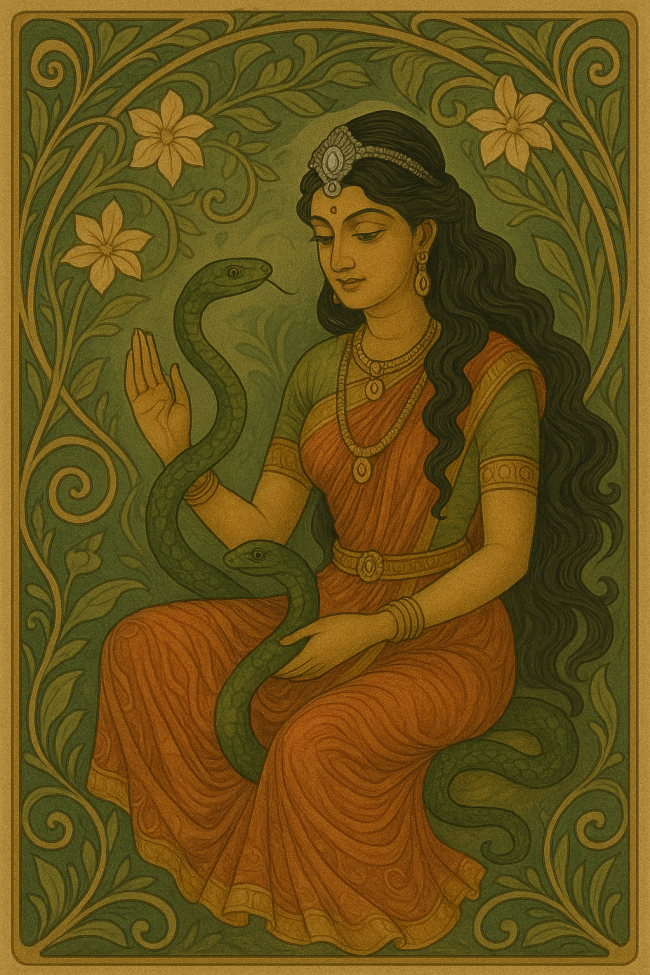Written by David Caldwell ·
Serpent Goddesses: Folklore and Reverence from Egypt to India
Across ancient cultures, serpents have played a central role in mythology and religious belief. Though often feared, snakes were also revered as potent symbols of fertility, wisdom, rebirth, and divine feminine power. From Ancient Egypt to the temples of South India, serpent goddesses emerged as manifestations of natural forces, ancestral spirits, and protectors of sacred spaces. Victorian and early 20th-century writers, fascinated by the exoticism of Eastern traditions, recorded much of this folklore, often filtered through colonial and Christian lenses. Yet the stories they preserved still echo older, indigenous beliefs that link the snake to the feminine divine across continents.
The Snake in Ancient Egypt: Wadjet, the Eye of Protection
One of the earliest serpent goddesses was Wadjet, the cobra deity of Lower Egypt. She was depicted as a rearing cobra or a woman with a serpent's head, often shown on the crown of the Pharaohs. Wadjet was the protective spirit of the Nile Delta, associated with kingship, prophecy, and divine justice. She was also a nurturing mother goddess, her venomous bite defending her children while her watchful eye (eventually fused with the "Eye of Ra") surveyed and protected all.
The uraeus, the stylised cobra on royal headdresses, served as a living symbol of Wadjet's power. Her association with the sun god Ra placed her among the celestial protectors, and her image adorned amulets worn for safety in life and the afterlife.
Minoan Crete: The Snake Priestess and Household Spirits
On the island of Crete, snake goddesses appeared in religious iconography of the Minoan civilisation (c. 2000?1450 BCE). The famous faience figurines from Knossos show bare-breasted priestesses holding snakes in each hand, their faces calm and commanding.
Though we lack direct textual sources from the Minoans, later Greek writers and archaeological interpretations suggest that these figures were both priestesses and representations of the goddess herself. The snake was not just a chthonic (underworld) symbol, it was a guardian of the home, fertility, and agricultural abundance. In Minoan belief, snakes lived close to the earth and were considered mediators between the mortal and divine realms.
Greek Transformations: Athena, Medusa, and Hygieia
Greek mythology inherited and transformed earlier serpent traditions. Athena, goddess of wisdom, bore a shield edged with serpents and wore the snake-haired Medusa's head as a protective emblem. Medusa herself, once a maiden priestess of Athena, was transformed into a monster whose gaze could turn men to stone, interpreted by some scholars as the demonisation of older goddess cults.
The goddess Hygieia, daughter of Asclepius, held a serpent entwined around a bowl or staff, still used as a symbol of medicine today. Her snake was a bringer of healing, wisdom, and purification. This healing serpent, tied to the earth and its powers, embodied life, death, and renewal.
Eve and the Biblical Rewriting of the Snake
In the Hebrew Bible, the snake appears in the Garden of Eden as the deceiver of Eve. While traditionally interpreted as a symbol of temptation and sin, many scholars believe this version of the snake reflects a reinterpretation of older goddess and serpent myths.
Earlier Mesopotamian myths, such as those of Inanna and the Huluppu tree, present serpents as guardians of sacred knowledge and divine femininity. The Edenic story may represent a patriarchal inversion, transforming a once-wise and empowering serpent into a figure of moral downfall.
Indian Serpent Goddesses: Folk Traditions and Living Belief
In South Asia, the serpent goddess remains a living tradition. Goddesses like Manasa, Naga Devi, and Subbaraya are worshipped throughout India, especially in Bengal, Tamil Nadu, Kerala, and Karnataka.
Victorian and early 20th-century colonial newspapers recorded tales of snake goddesses in awed tones, sometimes mockingly, often through a filter of Western rationalism. One article from The Civil and Military Gazette (1897) recounts a 14-day Malabar ritual where a young Nair girl performs a trance-like dance until the spirit of the snake goddess possesses her. She then prophesies and blesses offerings to protect the family from illness.
In another account, a dream led a washerman to a buried clay pot containing gold and a vessel believed to house the essence of the goddess Miriama. Once found, a temple was built, and annual rituals included blood offerings, music, and invocations for fertility and healing. The goddess Miriama was linked to protection from smallpox and epidemics.
In the region of Travancore, granite rocks shaped like snakes are worshipped as living deities. Devotees offer turmeric, milk, flowers, and prayers to these stones, and consider any snake that drinks the milk a sign that their prayer has been accepted.
Children?s teething ceremonies often involve shaving the head and dedicating the hair to the serpent goddess. Snakes that inhabit groves or kaavus are seen not as threats, but as ancestral protectors. To cut down a tree in such a sacred grove is considered a dangerous taboo.
Women lay offerings of flowers before serpent stones, touching carved snake heads with paint in the hope of blessings. In South Canara, a shrine on the Western Ghats contains the image of Subbaraya, said to be no more than a granite lump. But its power is feared and revered. Worshippers will not defile it, lest the wrathful god punish them.
Many such practices persist in rural India, especially during the Naga Panchami festival, when cobras are honoured with offerings of milk and turmeric.
Manasa: The Serpent Goddess of Bengal
Manasa, the serpent goddess of Bengal and north-eastern India, embodies the persistence of pre-Vedic, possibly indigenous traditions. She is often seen as a goddess of healing, fertility, and protection from snakebites, especially revered among lower-caste and tribal communities.
Manasa's origin myths vary. In one widely known legend, she is born from Shiva?s mind or sweat and rejected by him. Denied a place among the major gods, she struggles for recognition, eventually forcing worship through trials and miracles. She becomes the focus of the Bengali Manasa Mangal epics, where her rivalry with the wealthy merchant Chand Saudagar is central.
Chand refuses to worship her, mocking her status. In revenge, Manasa causes the death of his seven sons. Only after a long period of suffering and supernatural intervention does Chand's daughter-in-law, Behula, sail with her husband's corpse and undertake trials that eventually compel Chand to offer even a reluctant flower to Manasa. At this, the goddess restores the dead sons to life.
This story is more than myth, it reflects the assertion of local, feminine deities over patriarchal, elite resistance. In many ways, Manasa represents the survival of matrilineal worship in a world increasingly dominated by Brahmanical orthodoxy.
Folklore Echoes in Colonial Records
European reports, such as those from La Belle Assembl?e and The Civil and Military Gazette, documented these traditions with a mix of astonishment, romanticism, and sometimes condescension. Yet, behind their exoticised prose lies a window into living religious practices.
From tales of sacred snake rocks that bleed when desecrated, to stories of women becoming oracles of the cobra goddess, these accounts hint at a matrifocal spiritual ecology where snakes and women were often linked. Some reports describe festivals where women daub their foreheads with white clay, then enter trance states to receive visions from the snake goddess.
Other colonial accounts tell of temples where priests refuse to kill cobras, even when bitten, believing that the snake is a god. Some tales report that a snake once fed from the hands of a widow, later blessing her with fertility, a story reflecting the hopeful aspect of serpent worship.
A Cross-Cultural Serpent Archetype
The recurring motif of the serpent goddess reveals a cross-cultural archetype, one that ties together fertility, healing, death, and renewal. Serpent goddesses represent the liminal, the cyclical, and the potent forces of the natural world. Though interpreted through various lenses, Egyptian, Greek, Indian, or Biblical, the snake as a symbol of the divine feminine persists.
While colonial narratives often distorted or sensationalised indigenous traditions, they also unwittingly preserved vital threads of folklore. Modern scholarship increasingly recognises these snake goddesses not as quaint relics, but as expressions of complex, enduring spiritual beliefs.
Today, the snake goddess still slithers through dreams, dances in rural shrines, and waits in the stone and soil, offering protection, healing, and awe to those who remember her ways.
Related Articles
8 November 2025
How the Conquering Sun Became the Conquering Galilean26 October 2025
Elmet A Brittonic Kingdom and Enclave Between Rivers and Ridges24 October 2025
The Ebionites: When the Poor Carried the Gospel12 October 2025
Queen of Heaven: From the Catacombs to the Reformation4 October 2025
The Ancient Blood: A History of the Vampire27 September 2025
Epona: The Horse Goddess in Britain and Beyond26 September 2025
Witchcraft is Priestcraft: Jane Wenham and the End of England’s Witches20 September 2025
The Origins of Easter: From Ishtar and Passover to Eggs and the Bunny12 September 2025
Saint Cuthbert: Life, Death & Legacy of Lindisfarne’s Saint7 September 2025
The Search for the Ark of the Covenant: From Egypt to Ethiopia5 September 2025
The Search for Camelot: Legend, Theories, and Evidence1 September 2025
The Hell Hound Legends of Britain25 August 2025
The Lore of the Unicorn - A Definitive Guide23 August 2025
Saint Edmund: King, Martyr, and the Making of a Cult14 August 2025
The Great Serpent of Sea and Lake11 August 2025
The Dog Days of Summer - meanings and origins24 June 2025
The Evolution of Guardian Angels19 June 2025
Dumnonia The Sea Kingdom of the West17 June 2025
The Roman Calendar, Timekeeping in Ancient Rome14 June 2025
Are There Only Male Angels?

